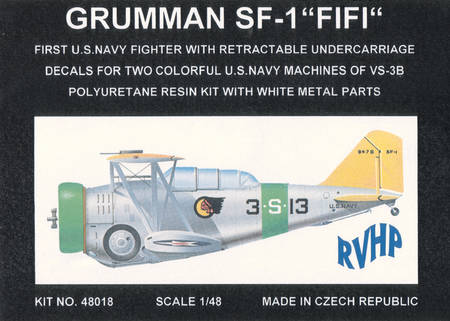She is a fine looking kit and it gives me the opportunity to Brag on the National Museum of Naval Aviation again.
"It was just two months after the stock market crash of October 1929 that six men led by Leroy Randle Grumman, a former naval aviator, formed the Grumman Aircraft Engineering Corporation, their first work for the Navy being the construction of pontoon floats for seaplanes. The floats, which featured retractable landing gear, attracted the interest of the sea service for the potential application of retractable landing gear to fighter aircraft to improve their performance. Grumman submitted a design proposal and on 2 April 1931, the Navy awarded the company a contract to build what would become the FF-1, the first in a long line of Grumman fighter aircraft to serve the Navy.
The FF-1 proved revolutionary not only in its retractable landing gear, but also with its all metal, stressed skin fuselage and enclosed cockpit, all giant steps forward in aircraft design. Though its forward fuselage was bulbous in order to house the retracted landing gear, the FF-1's top speed of 207 M.P.H. belied its less than streamlined appearance. This became readily apparent to a U.S. Army squadron commander, who upon seeing one flying during an exercise over Hawaii, decided to jump the strange bird with no wheels. "Great was his amazement," reported the Bureau of Aeronautics Newsletter on 1 March 1933, "when his dive upon the innocent looking target failed to close the range." In fact, the only significant drawback to the aircraft was its poor climb capability, taking over six minutes to reach an altitude of 10,000 ft.
Quickly called "Fifi," by pilots, a nickname derived from the aircraft?s designation "FF-1," the new fighter entered fleet service in May 1933, first equipping the Fighting Squadron (VF) 5B "Red Rippers." Grumman also manufactured a scouting version of the "Fifi," designated the SF-1, which served as command aircraft in fighter squadrons and also equipped Scouting Squadron (VS) 3B. All told, sixty-four aircraft (both fighter and scout versions) rolled off the Grumman assembly line. Though their service as front-line aircraft in the Navy would last but two years, FF-2s (FF-1s modified with dual controls) received a new lease on life in the training command. In addition, in 1936 Canadian Car & Foundry acquired the rights to construct a version of the aircraft designated the G-23, examples of which were operated by Canada, Japan, Mexico, Spain and Nicaragua. In Spanish livery the aircraft served the Republican side in the Spanish Civil War, with one claiming a kill of a Legión Cóndor Heinkel aircraft, the only combat victory ever scored by a Grumman biplane.
The sole G-23 purchased by the Nicaraguan government was one of three different aircraft procured to form the basis of that nation's air force. After seeing limited service, it was relegated to a scrap yard at Zololtan Air Field in 1942, destined to remain there until good fortune shined upon it and the keepers of naval aviation history. In 1961, J.R. Sirmons, an Oklahoma fertilizer and spray plane pilot hired to work in Nicaragua, discovered the G-23. Noting its similarity to an early-Grumman biplane fighter, Sirmons paid $150 for the machine, which was virtually intact other than missing elevators, tail struts, one cabane strut, and all flying wires. Obtaining erection and maintenance information from Grumman, Sirmons set about putting the G-23 into flyable condition, substituting parts from other aircraft and replacing the existing R-1820 engine (which would not exceed 1,500 RPM) with a R-1340-AN-1. Additionally, Sirmon's wife and daughter helped sew fabric where needed.
By February 1966 the aircraft was restored to flying condition and Sirmons took it on a test hop, which revealed the G-23 to be "a delight to fly." After displaying the plane in Managua at the Annual Nicaraguan Armed Forces Day Celebration and a heated argument with a junior customs official, which resulted in a brief jail stay, Sirmons departed for the United States. After stops in El Salvador, Mexico, and Brownsville, Texas, the aircraft arrived in Longview, Texas. It remained there until 9 June 1966, at which time Sirmons flew the aircraft to Bethpage, New York, where officials at Grumman inspected it.
That fall Grumman acquired the G-23 from Sirmons and began to complete the restoration of the aircraft in the FF-1 configuration with the intention of displaying it around the country for a year before donating it to the Naval Aviation Museum. Painted in the markings of the "Red Rippers" of VF-5B, the aircraft flew the air show circuit until June 1967. On 6 June 1967, Captain Bill Scarborough, USN (Ret), departed Bethpage bound for Pensacola. After stops along the eastern seaboard, the "FF-1" arrived at Naval Air Station (NAS) Pensacola, three days later. After making low passes over the training carrier Lexington (CVT 16), Scarborough made a landing at Forrest Sherman Field. There, Vice Admiral Alexander S. Heyward, Chief of Naval Air Training, Rear Admiral Dick H. Guinn, Chief of Naval Air Basic Training, Captain James H. McCurtain, Officer-in-Charge of the Naval Aviation Museum, and others accepted it for the Navy. It is one of only a few aircraft to have been displayed in both museum buildings.
Specifications for the FF-1
Manufacturer: Grumman Aircraft Engineering Corporation
Dimensions: Length: 24 ft., 6 in.; Height: 11 ft., 1 in.; Wingspan: 34 ft., 6 in.
Weights: Empty: 3,076 lb.; Gross: 4,655 lb.
Power plant: One 750 hp Wright R-1820-F engine
Performance: Maximum Speed: 207 M.P.H.; Service Ceiling: 22,400 ft.; Range: 365 miles
Armament: Two fixed forward-firing .30-in. guns
Crew: Pilot
Aircraft in the Museum collection
FF-1 (painted in markings of BuNo 9351)- On indoor static display."













 I have been trying to acquire this kit or the FF-1 kit for a while. I have several 1/72 kits from MPM.
I have been trying to acquire this kit or the FF-1 kit for a while. I have several 1/72 kits from MPM.
